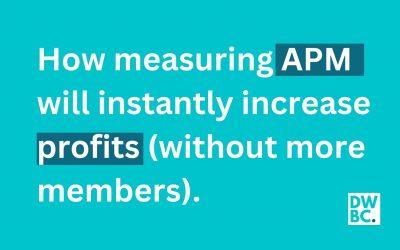Changes in any business metric over time gives you three distinct advantages.
Firstly, it allows you to spot trends in the direction your business is heading. Positive trends in the numbers provide reassurance that you’re on the right track and should persist with any current business strategies. Negative trends can be a sign that something needs to change – and often, the numbers can be an early warning that the bottom line will be affected in the near future.
Secondly, it allows you to find patterns and correlations between the actions you are completing within your business, and how they transfer to the bottom line. This bottom line will be a lagging indicator of the success of the actions and behaviours you’re undertaking.
The final benefit of tracking KPIs is that it allows you to identify bright spots (things you’re doing well), and opportunities (things you could be doing better). With this information, you can double down on the things you’re doing well, and address those that you’re not.
With Range of Motion Business Mentoring Clients, we recommend that you track all your KPIs monthly, though suggest that you do them at the mid-point of each month to give time for all the data of the previous month to come through, and all accounts to be reconciled. All KPIs should be tracked in a spreadsheet, with a different column for each month, and each KPI on its own row.
So what numbers should we track as part fo your monthly KPIs?
General KPIs:
New leads: Tracking the number of all new enquiries is one of the best measures of the success of your external marketing (including brand awareness). Finding relationships between your new enquires and your marketing efforts will help direct your marketing. Although you won’t track it in your KPI’s spreadsheet, you should also be tracking the source of all leads in a separate spreadsheet. This will provide further info on exactly how the client found out about you.
New paying clients: While new leads are an effective way of identifying all enquires, you should also measure all new paying clients. Looking at the percentage of all new leads who become paying clients is a valuable way to measure the success of the initial steps of your client journey.
Client departures: New leads and new clients are worth little if they don’t hang around. You should not only track the number of client departures, but also the reasons for each departure. While new leads tell you about your external marketing, and new paying clients tell you about the success of your sales process, client departures tell you how much value you’re providing and how good the experience is. This is possibly the most important KPI to tell you how good you are at doing what you promise.
Active clients: A great KPI to track the long term trending of your business, active clients are your current total paying clients. This number encapsulates both new paying clients and client departures. An positive upwards trend (increase in active clients) is a great indicator of business growth.
Net increase/decrease in client numbers: The number of active clients this month, minus the number of active clients last month, will tell you how much your total active clients have increased or decreased month-to-month.
Retention of existing clients: This number will tell you how many of last month’s clients are still with you this month, giving you a retention rate. To calculate this number, use the equation: ((number of active clients last month – number of client departures this month)/number of active clients last month)*100). This gives you a percentage of last month’s clients who are still clients this month, without the data being clouded by any new clients.
Attrition of existing clients: Your attrition rate is simply your retention rate, minus 100. While retention rate is the number of clients you kept, attrition rate is the number of clients you lost.
Specific KPIs:
Once you have your general KPIs calculated, you can get a bit more specific to the individual services of your business. This is where you’ll track the numbers of people taking advantage of different types of services. This may include nutrition coaching, general memberships, online coaching, personal training (broken down to different staff members where appropriate) etc. For each of these KPIs, you’ll have a row in your spreadsheet not only for the number of people using that service, but also the income it derives (if a Personal Training session is $60, the income will be ‘number of Personal Training sessions x 60). Basically, any service-based product you provide, and the income you derive from it, should be broken down in your specific KPIs.
Total service-based revenue: Your service-based income can then be combined to provide a further KPI, total revenue. This will tell you how much money is coming into the business from services.
Individual product revenue: If you’re selling products as part of your business (like supplements, clothing etc – basically anything you have to buy at a wholesale rate which you then sell at a retail rate), you should have a row in your spreadsheet for each product. For each row, fill in the number of items you sold for that product.
Total product revenue: The sum of each of your individual product revenues.
Total revenue: How much money your business has brought in from all sources, your ‘total service-based revenue’ plus your ’total product revenue’.
To correct your monthly revenue numbers for length of month, public holiday etc, it’s also useful to have a row in your spreadsheet for ‘’workdays this month’. This will be the number of days your business was operational. Most months will have 20-23 working days (not including weekends or public holidays).
Based on the ‘weekdays per month’, KPI you can then have a row for:
Personal Training (or whatever specific service-based metric you’d like to measure) sessions per weekday: Total number of (insert metric here) divided by the number of workdays that month.
Revenue per weekday: Total revenue divided by the number of workdays that month. This tell you how much money your business is bringing in, on average, per day.
But of course, revenue is not an effective KPI for measuring the business’ success. What we really want to know, is profit. While $10,000,000 per year might seem like great revenue, it’s nothing special if your expenditures are $11,000,000 per year.
You should be able to find a breakdown of expenses through whatever accounting software you use (you will need to keep this reconciled before you do your KPIs for the previous month).
We suggest you have a row for each of the following expenses (not all may apply to you, and you may need some extras in there, but this is a good guide):
- Advertising
- Bank fees
- Cleaning
- Consulting and accounting
- Cost of Sales (these are the costs of the products you have sold)
- Donations to charity
- General expenses
- Gifts, clients and staff
- Insurance
- Light, power, heating
- Motor vehicle expenses (if you own/lease a vehicle through your business)
- Nutrition consult expenses
- Office expenses
- Payment to staff
- Printing and stationary
- Rent
- Repairs and maintenance
- Staff development and training
- Subscriptions
- Superannuation expenses
- Phone and internet
- Travel
- Wages, salaries, and drawings (by owner)
For each of these items, you’ll have a monetary figure.
Total expenses: The total amount of money you spent on the business that month, found by adding all individual expense items together.
Total expenses not including owner renumeration and super: This is a KPI we like to track for businesses that have ‘company status’ (if you have ‘Pty. Ltd.’ after your business name), because it allows us to know what the total expenses are if the salary or wage paid to the ‘owner’ is removed. Although the company is a separate legal entity for tax purposes, it’s nice to know how much money is staying ‘in house’.
Based on revenue and expenses, we can then calculate total profit for a range of operations in your business. For example, Personal Training income, minus Personal Training expenses, will give you a profit for Personal Training. You can do this for all services and products.
Finally, we look at our total profit, which really, is all that matters.
Total profit: Total income minus total expenses.
And again, for those businesses with ‘company status’ we also like to look at:
Total profit (not including owner renumeration and super): Total revenue minus (Total expenses not including owner renumeration and super).
By tracking these KPIs over time, you will know the numbers of your business on a month-by-month basis. If you measure your numbers, you can take steps to improve you numbers.




